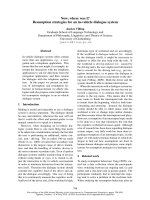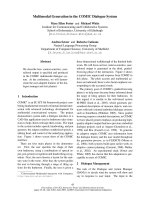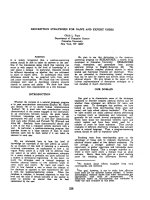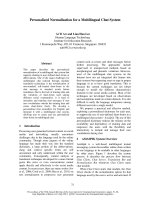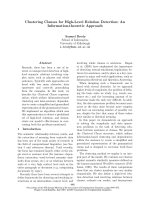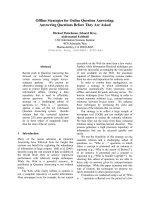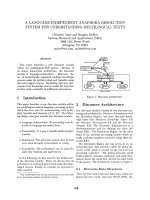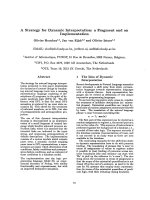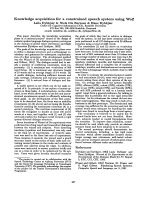Báo cáo khoa học: "Data-Driven Strategies for an Automated Dialogue System" potx
Bạn đang xem bản rút gọn của tài liệu. Xem và tải ngay bản đầy đủ của tài liệu tại đây (222.34 KB, 8 trang )
Data-Driven Strategies for an Automated Dialogue System
Hilda HARDY, Tomek
STRZALKOWSKI, Min WU
ILS Institute
University at Albany, SUNY
1400 Washington Ave., SS262
Albany, NY 12222 USA
hhardy|tomek|minwu@
cs.albany.edu
Cristian URSU, Nick WEBB
Department of Computer Science
University of Sheffield
Regent Court, 211 Portobello St.
Sheffield S1 4DP UK
,
Alan BIERMANN, R. Bryce
INOUYE, Ashley MCKENZIE
Department of Computer Science
Duke University
P.O. Box 90129, Levine Science
Research Center, D101
Durham, NC 27708 USA
awb|rbi|
Abstract
We present a prototype natural-language
problem-solving application for a financial
services call center, developed as part of the
Amitiés multilingual human-computer
dialogue project. Our automated dialogue
system, based on empirical evidence from real
call-center conversations, features a data-
driven approach that allows for mixed
system/customer initiative and spontaneous
conversation. Preliminary evaluation results
indicate efficient dialogues and high user
satisfaction, with performance comparable to
or better than that of current conversational
travel information systems.
1 Introduction
Recently there has been a great deal of interest in
improving natural-language human-computer
conversation. Automatic speech recognition
continues to improve, and dialogue management
techniques have progressed beyond menu-driven
prompts and restricted customer responses. Yet
few researchers have made use of a large body of
human-human telephone calls, on which to form
the basis of a data-driven automated system.
The Amitiés project seeks to develop novel
technologies for building empirically induced
dialogue processors to support multilingual
human-computer interaction, and to integrate these
technologies into systems for accessing
information and services (.
uk/nlp/amities). Sponsored jointly by the European
Commission and the US Defense Advanced
Research Projects Agency, the Amitiés Consortium
includes partners in both the EU and the US, as
well as financial call centers in the UK and France.
A large corpus of recorded, transcribed
telephone conversations between real agents and
customers gives us a unique opportunity to analyze
and incorporate features of human-human
dialogues into our automated system. (Generic
names and numbers were substituted for all
personal details in the transcriptions.) This corpus
spans two different application areas: software
support and (a much smaller size) customer
banking. The banking corpus of several hundred
calls has been collected first and it forms the basis
of our initial multilingual triaging application,
implemented for English, French and German
(Hardy et al., 2003a); as well as our prototype
automatic financial services system, presented in
this paper, which completes a variety of tasks in
English. The much larger software support corpus
(10,000 calls in English and French) is still being
collected and processed and will be used to
develop the next Amitiés prototype.
We observe that for interactions with structured
data – whether these data consist of flight
information, spare parts, or customer account
information – domain knowledge need not be built
ahead of time. Rather, methods for handling the
data can arise from the way the data are organized.
Once we know the basic data structures, the
transactions, and the protocol to be followed (e.g.,
establish caller’s identity before exchanging
sensitive information); we need only build
dialogue models for handling various
conversational situations, in order to implement a
dialogue system. For our corpus, we have used a
modified DAMSL tag set (Allen and Core, 1997)
to capture the functional layer of the dialogues, and
a frame-based semantic scheme to record the
semantic layer (Hardy et al., 2003b). The “frames”
or transactions in our domain are common
customer-service tasks: VerifyId, ChangeAddress,
InquireBalance, Lost/StolenCard and Make
Payment. (In this context “task” and “transaction”
are synonymous.) Each frame is associated with
attributes or slots that must be filled with values in
no particular order during the course of the
dialogue; for example, account number, name,
payment amount, etc.
2 Related Work
Relevant human-computer dialogue research
efforts include the TRAINS project and the
DARPA Communicator program.
The classic TRAINS natural-language dialogue
project (Allen et al., 1995) is a plan-based system
which requires a detailed model of the domain and
therefore cannot be used for a wide-ranging
application such as financial services.
The US DARPA Communicator program has
been instrumental in bringing about practical
implementations of spoken dialogue systems.
Systems developed under this program include
CMU’s script-based dialogue manager, in which
the travel itinerary is a hierarchical composition of
frames (Xu and Rudnicky, 2000). The AT&T
mixed-initiative system uses a sequential decision
process model, based on concepts of dialog state
and dialog actions (Levin et al., 2000). MIT’s
Mercury flight reservation system uses a dialogue
control strategy based on a set of ordered rules as a
mechanism to manage complex interactions
(Seneff and Polifroni, 2000). CU’s dialogue
manager is event-driven, using a set of hierarchical
forms with prompts associated with fields in the
forms. Decisions are based not on scripts but on
current context (Ward and Pellom, 1999).
Our data-driven strategy is similar in spirit to
that of CU. We take a statistical approach, in
which a large body of transcribed, annotated
conversations forms the basis for task
identification, dialogue act recognition, and form
filling for task completion.
3 System Architecture and Components
The Amitiés system uses the Galaxy
Communicator Software Infrastructure (Seneff et
al., 1998). Galaxy is a distributed, message-based,
hub-and-spoke infrastructure, optimized for spoken
dialogue systems.
Figure 1. Amitiés System Architecture
Components in the Amitiés system (Figure 1)
include a telephony server, automatic speech
recognizer, natural language understanding unit,
dialogue manager, database interface server,
response generator, and text-to-speech conversion.
3.1 Audio Components
Audio components for the Amitiés system are
provided by LIMSI. Because acoustic models have
not yet been trained, the current demonstrator
system uses a Nuance ASR engine and TTS
Vocalizer.
To enhance ASR performance, we integrated
static GSL (Grammar Specification Language)
grammar classes provided by Nuance for
recognizing several high-frequency items:
numbers, dates, money amounts, names and yes-no
statements.
Training data for the recognizer were collected
both from our corpus of human-human dialogues
and from dialogues gathered using a text-based
version of the human-computer system. Using this
version we collected around 100 dialogues and
annotated important domain-specific information,
as in this example: “Hi my name is [fname ;
David] [lname ; Oconnor] and my account number
is [account ; 278 one nine five].”
Next we replaced these annotated entities with
grammar classes. We also utilized utterances from
the Amitiés banking corpus (Hardy et al., 2002) in
which the customer specifies his/her desired task,
as well as utterances which constitute common,
domain-independent speech acts such as
acceptances, rejections, and indications of non-
understanding. These were also used for training
the task identifier and the dialogue act classifier
(Section 3.3.2). The training corpus for the
recognizer consists of 1744 utterances totaling
around 10,000 words.
Using tools supplied by Nuance for building
recognition packages, we created two speech
recognition components: a British model in the UK
and an American model at two US sites.
For the text to speech synthesizer we used
Nuance’s Vocalizer 3.0, which supports multiple
languages and accents. We integrated the
Vocalizer and the ASR using Nuance’s speech and
telephony API into a Galaxy-compliant server
accessible over a telephone line.
3.2 Natural Language Understanding
The goal of the language understanding
component is to take the word string output of the
ASR module, and identify key semantic concepts
relating to the target domain. This is a specialized
kind of information extraction application, and as
such, we have adapted existing IE technology to
this task.
Hub
Speech
Recognition
Dialogue
Manager
Database
Server
Nat’l Language
Understanding
Telephony
Server
Response
Generation
Customer
Database
Text-to-speech
Conversion
We have used a modified version of the ANNIE
engine (A Nearly-New IE system; Cunningham et
al., 2002; Maynard, 2003). ANNIE is distributed as
the default built-in IE component of the GATE
framework (Cunningham et al., 2002). GATE is a
pure Java-based architecture developed over the
past eight years in the University of Sheffield
Natural Language Processing group. ANNIE has
been used for many language processing
applications, in a number of languages both
European and non-European. This versatility
makes it an attractive proposition for use in a
multilingual speech processing project.
ANNIE includes customizable components
necessary to complete the IE task – tokenizer,
gazetteer, sentence splitter, part of speech tagger
and a named entity recognizer based on a powerful
engine named JAPE (Java Annotation Pattern
Engine; Cunningham et al., 2000).
Given an utterance from the user, the NLU unit
produces both a list of tokens for detecting
dialogue acts, an important research goal inside
this project, and a frame with the possible named
entities specified by our application. We are
interested particularly in account numbers, credit
card numbers, person names, dates, amounts of
money, locations, addresses and telephone
numbers.
In order to recognize these, we have updated the
gazetteer, which works by explicit look-up tables
of potential candidates, and modified the rules of
the transducer engine, which attempts to match
new instances of named entities based on local
grammatical context. There are some significant
differences between the kind of prose text more
typically associated with information extraction,
and the kind of text we are expecting to encounter.
Current models of IE rely heavily on punctuation
as well as certain orthographic information, such as
capitalized words indicating the presence of a
name, company or location. We have access to
neither of these in the output of the ASR engine,
and so had to retune our processors to data which
reflected that.
In addition, we created new processing
resources, such as those required to spot number
units and translate them into textual representations
of numerical values; for example, to take “twenty
thousand one hundred and fourteen pounds”, and
produce “£20,114”. The ability to do this is of
course vital for the performance of the system.
If none of the main entities can be identified
from the token string, we create a list of possible
fallback entities, in the hope that partial matching
would help narrow the search space.
For instance, if a six-digit account number is not
identified, then the incomplete number recognized
in the utterance is used as a fallback entity and sent
to the database server for partial matching.
Our robust IE techniques have proved
invaluable to the efficiency and spontaneity of our
data-driven dialogue system. In a single utterance
the user is free to supply several values for
attributes, prompted or unprompted, allowing tasks
to be completed with fewer dialogue turns.
3.3 Dialogue Manager
The dialogue manager identifies the goals of the
conversation and performs interactions to achieve
those goals. Several “Frame Agents”, implemented
within the dialogue manager, handle tasks such as
verifying the customer’s identity, identifying the
customer’s desired transaction, and executing those
transactions. These range from a simple balance
inquiry to the more complex change of address and
debit-card payment. The structure of the dialogue
manager is illustrated in Figure 2.
Rather than depending on a script for the
progression of the dialogue, the dialogue manager
takes a data-driven approach, allowing the caller to
take the initiative. Completing a task depends on
identifying that task and filling values in frames,
but this may be done in a variety of ways: one at a
time, or several at once, and in any order.
For example, if the customer identifies himself
or herself before stating the transaction, or even if
he or she provides several pieces of information in
one utterance—transaction, name, account number,
payment amount—the dialogue manager is flexible
enough to move ahead after these variations.
Prompts for attributes, if needed, are not restricted
to one at a time, but they are usually combined in
the way human agents request them; for example,
city and county, expiration date and issue number,
birthdate and telephone number.
Figure 2. Amitiés Dialogue Manager
If the system fails to obtain the necessary values
from the user, reprompts are used, but no more
than once for any single attribute. For the customer
verification task, different attributes may be
Response Decision
Input:
from NLU via
Hub (token string,
language id,
named entities)
Task info
External files,
domain-specific
Dialogue Act
Classifier
Frame Agent
Task ID
Frame Agent
Verify-Caller
Frame Agent
DB Server
Customer
Database
Task Execution
Frame Agents
via Hub
Dialogue History
requested. If the system fails even after reprompts,
it will gracefully give up with an explanation such
as, “I’m sorry, we have not been able to obtain the
information necessary to update your address in
our records. Please hold while I transfer you to a
customer service representative.”
3.3.1 Task ID Frame Agent
For task identification, the Amitiés team has
made use of the data collected in over 500
conversations from a British call center, recorded,
transcribed, and annotated. Adapting a vector-
based approach reported by Chu-Carroll and
Carpenter (1999), the Task ID Frame Agent is
domain-independent and automatically trained.
Tasks are represented as vectors of terms, built
from the utterances requesting them. Some
examples of labeled utterances are: “Erm I'd like to
cancel the account cover premium that's on my,
appeared on my statement” [CancelInsurance] and
“Erm just to report a lost card please”
[Lost/StolenCard].
The training process proceeds as follows:
1. Begin with corpus of transcribed, annotated
calls.
2. Document creation: For each transaction, collect
raw text of callers’ queries. Yield: one
“document” for each transaction (about 14 of
these in our corpus).
3. Text processing: Remove stopwords, stem
content words, weight terms by frequency.
Yield: one “document vector” for each task.
4. Compare queries and documents: Create “query
vectors.” Obtain a cosine similarity score for
each query/document pair. Yield: cosine
scores/routing values for each query/document
pair.
5. Obtain coefficients for scoring: Use binary
logistic regression. Yield: a set of coefficients
for each task.
Next, the Task ID Frame Agent is tested on
unseen utterances or queries:
1. Begin with one or more user queries.
2. Text processing: Remove stopwords, stem
content words, weight terms (constant weights).
Yield: “query vectors”.
3. Compare each query with each document.
Yield: cosine similarity scores.
4. Compute confidence scores (use training
coefficients). Yield: confidence scores,
representing the system’s confidence that the
queries indicate the user’s choice of a particular
transaction.
Tests performed over the entire corpus, 80% of
which was used for training and 20% for testing,
resulted in a classification accuracy rate of 85%
(correct task is one of the system’s top 2 choices).
The accuracy rate rises to 93% when we eliminate
confusing or lengthy utterances, such as requests
for information about payments, statements, and
general questions about a customer’s account.
These can be difficult even for human annotators
to classify.
3.3.2 Dialogue Act Classifier
The purpose of the DA Classifier Frame Agent
is to identify a caller’s utterance as one or more
domain-independent dialogue acts. These include
Accept, Reject, Non-understanding, Opening,
Closing, Backchannel, and Expression. Clearly, it
is useful for a dialogue system to be able to
identify accurately the various ways a person may
say “yes”, “no”, or “what did you say?” As with
the task identifier, we have trained the DA
classifier on our corpus of transcribed, labeled
human-human calls, and we have used vector-
based classification techniques. Two differences
from the task identifier are 1) an utterance may
have multiple correct classifications, and 2) a
different stoplist is necessary. Here we can filter
out the usual stops, including speech dysfluencies,
proper names, number words, and words with
digits; but we need to include words such as yeah,
uh-huh, hi, ok, thanks, pardon and sorry.
Some examples of DA classification results are
shown in Figure 3. For sure, ok, the classifier
returns the categories Backchannel, Expression and
Accept. If the dialogue manager is looking for
either Accept or Reject, it can ignore Backchannel
and Expression in order to detect the correct
classification. In the case of certainly not, the first
word has a strong tendency toward Accept, though
both together constitute a Reject act.
Text: “sure, okay”
Text: “certainly not”
Categories returned: Backchannel,
Expression, Accept
Categories returned:
Reject, Accept
Expression
Closing
Accept
Back.
0
0.2
0.4
0.6
0.8
1
Top four cosine scores
Expression
Accept
Closing
Back.
0
0.1
0.2
0.3
0.4
0.5
0.6
0.7
Confidence scores
Rejec t
Reject-part
Accept
Expression
0
0.1
0.2
0.3
0.4
0.5
0.6
Top four cosine scores
Rejec t
Accept
Expression
Reject-part
0
0.1
0.2
0.3
0.4
0.5
0.6
0.7
Confidence scores
Figure 3. DA Classification examples
Our classifier performs well if the utterance is
short and falls into one of the selected categories
(86% accuracy on the British data); and it has the
advantages of automatic training, domain
independence, and the ability to capture a great
variety of expressions. However, it can be
inaccurate when applied to longer utterances, and it
is not yet equipped to handle domain-specific
assertions, questions, or queries about a
transaction.
3.4 Database Manager
Our system identifies users by matching
information provided by the caller against a
database of user information. It assumes that the
speech recognizer will make errors when the caller
attempts to identify himself. Therefore perfect
matches with the database entries will be rare.
Consequently, for each record in the database, we
attach a measure of the probability that the record
is the target record. Initially, these measures are
estimates of the probability that this individual will
call. When additional identifying information
arrives, the system updates these probabilities
using Bayes’ rule.
Thus, the system might begin with a uniform
probability estimate across all database records. If
the user identifies herself with a name recognized
by the machine as “Smith”, the system will
appropriately increment the probabilities of all
entries with the name “Smith” and all entries that
are known to be confused with “Smith” in
proportion to their observed rate of substitution. Of
course, all records not observed to be so
confusable would similarly have their probabilities
decreased by Bayes’ rule. When enough
information has come in to raise the probability for
some record above a threshold (in our system 0.99
probability), the system assumes that the caller has
been correctly identified. The designer may choose
to include a verification dialog, but our decision
was to minimize such interactions to shorten the
calls.
Our error-correcting database system receives
tokens with an identification of what field each
token should represent. The system processes the
tokens serially. Each represents an observation
made by the speech recognizer. To process a token,
the system examines each record in the database
and updates the probability that the record is the
target record using Bayes’ rule:
where rec is the event where the record under
consideration is the target record.
As is common in Bayes’ rule calculations, the
denominator P(obs) is treated as a scaling factor,
and is not calculated explicitly. All probabilities
are renormalized at the end of the update of all of
the records. P(rec) is the previous estimate of the
probability that the record is the target record.
P(obs|rec) is the probability that the recognizer
returned the observation that it did given that the
target record is the current record under
examination. For some of the fields, such as the
account number and telephone number, the user
responses consist of digits. We collected data on
the probability that the speech recognition system
we are using mistook one digit for another and
calculated the values for P(obs|rec) from the data.
For fields involving place names and personal
names, the probabilities were estimated.
Once a record has been selected (by virtue of its
probability being greater than the threshold) the
system compares the individual fields of the record
with values obtained by the speech recognizer. If
the values differ greatly, as measured by their
Levenshtein distance, the system returns the field
name to the dialogue manager as a candidate for
additional verification. If no record meets the
threshold probability criterion, the system returns
the most probable record to the dialogue manager,
along with the fields which have the greatest
Levenshtein distance between the recognized and
actual values, as candidates for reprompting.
Our database contains 100 entries for the system
tests described in this paper. We describe the
system in a more demanding environment with one
million records in Inouye et al. (2004). In that
project, we required all information to be entered
by spelling the items out so that the vocabulary
was limited to the alphabet plus the ten digits. In
the current project, with fewer names to deal with,
we allowed the complete vocabulary of the
domain: names, streets, counties, and so forth.
3.5 Response Generator
Our current English-only system preserves the
language-independent features of our original tri-
lingual generator, storing all language- and
domain-specific information in separate text files.
It is a template-based system, easily modified and
extended. The generator constructs utterances
according to the dialogue manager’s specification
of one or more speech acts (prompt, request,
confirm, respond, inform, backchannel, accept,
reject), repetition numbers, and optional lists of
attributes, values, and/or the person’s name. As far
as possible, we modeled utterances after the
human-human dialogues.
For a more natural-sounding system, we
collected variations of the utterances, which the
generator selects at random. Requests, for
example, may take one of twelve possible forms:
Request, part 1 of 2:
Can you just confirm | Can I have | Can I take |
What is | What’s | May I have
)(
)()|(
)|(
obsP
recPrecobsP
obsrecP
×
=
Request, part 2 of 2:
[list of attributes], [person name]? | [list of
attributes], please?
Offers to close or continue the dialogue are
similarly varied:
Closing offer, part 1 of 2:
Is there anything else | Anything else | Is there
anything else at all
Closing offer, part 2 of 2:
I can do for you today? | I can help you with
today? | I can do for you? | I can help you with? |
you need today? | you need?
4 Preliminary Evaluation
Ten native speakers of English, 6 female and 4
male, were asked to participate in a preliminary in-
lab system evaluation (half in the UK and half in
the US). The Amitiés system developers were not
among these volunteers. Each made 9 phone calls
to the system from behind a closed door, according
to scenarios designed to test various customer
identities as well as single or multiple tasks. After
each call, participants filled out a questionnaire to
register their degree of satisfaction with aspects of
the interaction.
Overall call success was 70%, with 98%
successful completions for the VerifyId and 96%
for the CheckBalance subtasks (Figure 4).
“Failures” were not system crashes but simulated
transfers to a human agent. There were 5 user
terminations.
Average word error rates were 17% for calls that
were successfully completed, and 22% for failed
calls. Word error rate by user ranged from 11% to
26%.
0.70
0.98
0.96
0.88
0.90
0.57
0.85
0.00
0.20
0.40
0.60
0.80
1.00
1.20
Cal
l
S
uc
c
e
s
s
Ve
r
ify
Id
Che
c
kBalance
LostCard
MakePayment
Ch
ang
eA
d
dr
e
s
s
Finish
Di
alogue
Figure 4. Task Completion Rates
Call duration was found to reflect the
complexity of each scenario, where complexity is
defined as the number of “concepts” needed to
complete each task. The following items are
judged to be concepts: task identification; values
such as first name, last name, house number, street
and phone number; and positive or negative
responses such as whether a new card is desired.
Figures 5 and 6 illustrate the relationship between
length of call and task complexity. It should be
noted that customer verification, a task performed
in every dialogue, requires a minimum of 3
personal details to be verified against a database
record, but may require more in the case of
recognition errors.
The overall average number of turns per
dialogue was 18.28. The user spoke an average of
6.89 words per turn and the system 11.42.
User satisfaction for each call was assessed by
way of a questionnaire containing five statements.
These covered the clarity of the instructions, ease
of doing the task, how well the system understands
the caller, how well the system works, and the
caller’s enjoyment of the system. Participants rated
each on a five-point Likert scale. Summed results
showed an average score of 20.45 over all users
(range 5–25; higher = stronger agreement).
0
2
4
6
8
10
12
123456789
Sce nario
Number of concepts
85.0
135.8
119.3
88.3
106.7
114.0
48.4
109.3
127.1
0.0
20.0
40.0
60.0
80.0
100.0
120.0
140.0
160.0
123456789
Figures 5 and 6. Scenario Complexity (top) and
Average Call Duration by Scenario (in seconds)
Although user satisfaction was high, we were
more interested in identifying the major problems
for the callers. Users were often frustrated by
recognition failures and/or unsuccessful attempts
to capture values such as a new street address,
county, or phone number. Sometimes the system
failed to determine that the user was finished.
Because the system is designed to be non-
restrictive in accepting users’ input,
misidentifications were common. One user spoke
for many by saying, “There were times when the
system would ask me to repeat information I had
not yet given to it.” We plan to revise our strategy
so that we are a little more cautious in our
reprompts. Occasionally, the system misidentified
the user’s desired task and had difficulty backing
off gracefully and starting the correct task. We are
working on improving our recovery strategies for
these cases.
The following transcription of an interaction
with our system illustrates the efficiency made
possible when the data supplied by the caller drives
the conversation:
AMITIÉS: Hello, this is Am-ih-tee-eh! What can
I do for you?
USER: yes this is Stella Lang. My card number
is three one six seven one four. Can you tell me the
balance on my account please?
AMITIÉS: Can you just confirm the city and
county?
USER: uh yes it’s London, Middlesex
AMITIÉS: I’m sorry, I didn’t understand what
you said. Can you repeat, please?
USER: London, Middlesex
AMITIÉS: All right, your balance is 1753
pounds and 20 pence. Anything else I can do for
you?
USER: yes I'd like to make a payment of fifty
three pounds with my debit card please
AMITIÉS: Can I have the debit card number,
Miss Lang?
USER: sure, it's two eight seven four six six four
nine five eight nine five three eight nine one, and it
expires October two thousand six
AMITIÉS: What's the issue number, please?
USER: one
AMITIÉS: Ok, Miss Lang, I'll send in the
payment amount of 53 pounds. Did I get that right?
USER: yes, what's my new balance please?
AMITIÉS: Ok, that's gone through. Your
payment will be credited overnight and will reflect
on your next statement. Your balance is 1700
pounds and 20 pence. Anything else I can do for
you today?
USER: no, that's it thanks
AMITIÉS: Thanks very much for your call,
goodbye.
USER: bye
5 Discussion, Future Work
The preliminary evaluation reported here
indicates promise for an automated dialogue
system such as ours, which incorporates robust
techniques for information extraction, record
matching, task identification, dialogue act
classification, and an overall data-driven strategy.
Task duration and number of turns per dialogue
both appear to indicate greater efficiency and
corresponding user satisfaction than many other
similar systems. In the DARPA Communicator
evaluation, for example, between 60 and 79 calls
were made to each of 8 participating sites (Walker,
et al., 2001, 2002). A sample scenario for a
domestic round-trip flight contained 8 concepts
(airline, departure city, state, date, etc.). The
average duration for such a call was over 300
seconds; whereas our overall average was 104
seconds. ASR accuracy rates in 2001 were about
60% and 75%, for airline itineraries not completed
and completed; and task completion rates were
56%. Our average number of user words per turn,
6.89, is also higher than that reported for
Communicator systems. This number seems to
reflect lengthier responses to open prompts,
responses to system requests for multiple
attributes, and greater user initiative.
We plan to port the system to a new domain:
from telephone banking to information-technology
support. As part of this effort we are again
collecting data from real human-human calls. For
advanced speech recognition, we hope to train our
ASR on new acoustic data. We also plan to expand
our dialogue act classification so that the system
can recognize more types of acts, and to improve
our classification reliability.
6 Acknowledgements
This paper is based on work supported in part by
the European Commission under the 5
th
Framework IST/HLT Programme, and by the US
Defense Advanced Research Projects Agency.
References
J. Allen and M. Core. 1997. Draft of DAMSL:
Dialog Act Markup in Several Layers.
/>ces/damsl/.
J. Allen, L. K. Schubert, G. Ferguson, P. Heeman,
Ch. L. Hwang, T. Kato, M. Light, N. G. Martin,
B. W. Miller, M. Poesio, and D. R. Traum.
1995. The TRAINS Project: A Case Study in
Building a Conversational Planning Agent.
Journal of Experimental and Theoretical AI, 7
(1995), 7–48.
Amitiés,
J. Chu-Carroll and B. Carpenter. 1999. Vector-
Based Natural Language Call Routing.
Computational Linguistics, 25 (3): 361–388.
H. Cunningham, D. Maynard, K. Bontcheva, V.
Tablan. 2002. GATE: A Framework and
Graphical Development Environment for Robust
NLP Tools and Applications. Proceedings of the
40th Anniversary Meeting of the Association for
Computational Linguistics (ACL'02),
Philadelphia, Pennsylvania.
H. Cunningham and D. Maynard and V. Tablan.
2000. JAPE: a Java Annotation Patterns Engine
(Second Edition). Technical report CS 00 10,
University of Sheffield, Department of
Computer Science.
DARPA,
H. Hardy, K. Baker, L. Devillers, L. Lamel, S.
Rosset, T. Strzalkowski, C. Ursu and N. Webb.
2002. Multi-Layer Dialogue Annotation for
Automated Multilingual Customer Service.
Proceedings of the ISLE Workshop on Dialogue
Tagging for Multi-Modal Human Computer
Interaction, Edinburgh, Scotland.
H. Hardy, T. Strzalkowski and M. Wu. 2003a.
Dialogue Management for an Automated
Multilingual Call Center. Research Directions in
Dialogue Processing, Proceedings of the HLT-
NAACL 2003 Workshop, Edmonton, Alberta,
Canada.
H. Hardy, K. Baker, H. Bonneau-Maynard, L.
Devillers, S. Rosset and T. Strzalkowski. 2003b.
Semantic and Dialogic Annotation for
Automated Multilingual Customer Service.
Eurospeech 2003, Geneva, Switzerland.
R. B. Inouye, A. Biermann and A. Mckenzie.
2004. Caller Identification from Spelled-Out
Personal Data Using a Database for Error
Correction. Duke University Internal Report.
E. Levin, S. Narayanan, R. Pieraccini, K. Biatov,
E. Bocchieri, G. Di Fabbrizio, W. Eckert, S.
Lee, A. Pokrovsky, M. Rahim, P. Ruscitti, and
M. Walker. 2000. The AT&T-DARPA
Communicator Mixed-Initiative Spoken Dialog
System. ICSLP 2000.
D. Maynard. 2003. Multi-Source and Multilingual
Information Extraction. Expert Update.
S. Seneff, E. Hurley, R. Lau, C. Pao, P. Schmid,
and V. Zue. 1998. Galaxy-II: A Reference
Architecture for Conversational System
Development. ICSLP 98, Sydney, Australia.
S. Seneff and J. Polifroni. 2000. Dialogue
Management in the Mercury Flight Reservation
System. Satellite Dialogue Workshop, ANLP-
NAACL, Seattle, Washington.
M. Walker, J. Aberdeen, J. Boland, E. Bratt, J.
Garofolo, L. Hirschman, A. Le, S. Lee, S.
Narayanan, K. Papineni, B. Pellom, J. Polifroni,
A. Potamianos, P. Prabhu, A. Rudnicky, G.
Sanders, S. Seneff, D. Stallard and S. Whittaker.
2001. DARPA Communicator Dialog Travel
Planning Systems: The June 2000 Data
Collection. Eurospeech 2001.
M. Walker, A. Rudnicky, J. Aberdeen, E. Bratt, J.
Garofolo, H. Hastie, A. Le, B. Pellom, A.
Potamianos, R. Passonneau, R. Prasad, S.
Roukos, G. Sanders, S. Seneff and D. Stallard.
2002. DARPA Communicator Evaluation:
Progress from 2000 to 2001. ICSLP 2002.
W. Ward and B. Pellom. 1999. The CU
Communicator System. IEEE ASRU, pp. 341–
344.
W. Xu and A. Rudnicky. 2000. Task-based Dialog
Management Using an Agenda. ANLP/NAACL
Workshop on Conversational Systems, pp. 42–
47.
